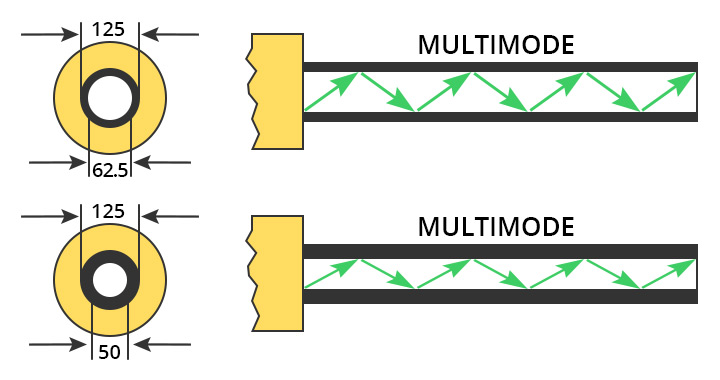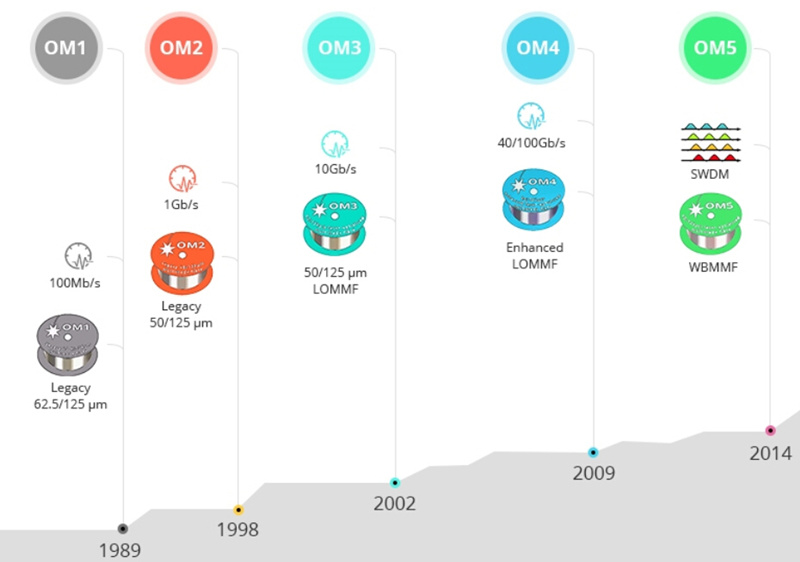Categories
Latest Blog
Multimode Fiber Types Introduction and Application
Multimode Fiber Types Introduction and Application
Multimode fiber is a common choice to achieve 10 Gbit/s speed over distances required by LAN enterprise and data center applications. There are several kinds (OM1 vs OM2 vs OM3 vs OM4 vs OM5) of multimode fiber types available for high-speed network installations, and each with a different reach and data-rate capability. With so many options, it can be tough to select the most suitable multimode fiber. OM1 vs OM2 vs OM3 vs OM4 vs OM5, which to choose? You may get answer in this article.
Multimode fiber (MMF) is a kind of optical fiber mostly used in communication over short distances, for example, inside a building or for the campus. Multimode fiber optic cable has a larger core, typically 50 or 62.5 microns that enables multiple light modes to be propagated. Because of this, more data can pass through the multimode fiber core at a given time. The maximum transmission distance for MMF cable is around 550m at the speed of 10Git/s. It can transmit farther at lower data rates, such as going about 2km at 100Mb/s.

Identified by ISO 11801 standard, multimode fiber optic cables can be classified into OM1 fiber, OM2 fiber, OM3 fiber, OM4 fiber and newly released OM5 fiber. The next part will compare these fibers from the side of core size, bandwidth, data rate, distance, color and optical source in details.

OM1 fiber typically comes with an orange jacket and have a core size of 62.5 µm. It can support 10 Gigabit Ethernet at lengths of up to 33 meters. It is most commonly used for 100 Megabit Ethernet applications. This type commonly uses a LED light source.
Likewise, OM2 fiber also comes with an orange jacket and uses a LED light source but with a smaller core size of 50 µm. It supports up to 10 Gigabit Ethernet at lengths up to 82 meters but is more commonly used for 1 Gigabit Ethernet applications.
OM3 fiber comes with an aqua color jacket. Like the OM2, its core size is 50 µm, but the cable is optimized for laser based equipment. OM3 supports 10 Gigabit Ethernet at lengths up to 300 meters. Besides, OM3 is able to support 40 Gigabit and 100 Gigabit Ethernet up to 100 meters, however, 10 Gigabit Ethernet is most commonly used.
OM4 fiber is completely backwards compatible with OM3 fiber and shares the same distinctive aqua jacket. OM4 was developed specifically for VSCEL laser transmission and allows 10 Gig/s link distances of up to 550m compared to 300M with OM3. And it’s able to run 40/100GB up to 150 meters utilizing a MPO connector.
OM5 fiber, also known as WBMMF (wideband multimode fiber), is the newest type of multimode fiber, and it is backwards compatible with OM4. It has the same core size as OM2, OM3, and OM4. The color of OM5 fiber jacket was chosen as lime green. It is designed and specified to support at least four WDM channels at a minimum speed of 28Gbps per channel through the 850-953 nm window.
OM1 vs OM2 vs OM3 vs OM4 vs OM5: What's the Difference?
The prime distinction between multimode fibers rests on physical difference. Accordingly, physical difference leads to different transmission data rate and distance. Watch the following video to learn the differences between OM1, OM2, OM3, OM4 & OM5 multimode fibers.
Physical difference mainly lies in diameter, jacket color, optical source and bandwidth, which is described in the following table.
| MMF Cable Type | Diameter | Jacket Color | Optical Source | Bandwidth |
|---|---|---|---|---|
| OM1 | 62.5/125µm | Orange | LED | 200MHz*km |
| OM2 | 50/125µm | Orange | LED | 500MHz*km |
| OM3 | 50/125µm | Aqua | VSCEL | 2000MHz*km |
| OM4 | 50/125µm | Aqua | VSCEL | 4700MHz*km |
| OM5 | 50/125µm | Lime Green | VSCEL | 28000MHz*km |
Multimode fibers are able to transmit different distance ranges at various data rate. You can choose the most suited one according to your actual application. The max multimode fiber distance comparison at different data rate is specified below.
| MMF Category | Fast Ethernet | 1GbE | 10GbE | 40GbE | 100GbE |
|---|---|---|---|---|---|
| OM1 | 2000m | 275m | 33m | / | / |
| OM2 | 2000m | 550m | 82m | / | / |
| OM3 | 2000m | / | 300m | 100m | 70m |
| OM4 | 2000m | / | 550m | 150m | 150m |
| OM5 | / | / | 550m | 150m | 150m |
Although single mode fiber patch cable is advantageous in terms of bandwidth and reach for longer distances, multimode fiber easily supports most distances required for enterprise and data center networks at a cost dramatically less than single mode fiber. Besides, multimode fiber optic cable still has many significant advantages.
Multimode fiber features carrying multiple signals at the same time in the same line. Most importantly, the total power inside the signals carries almost no loss. Therefore, the network user can send more than one packet in the cable at the same time, and all information will be delivered to their destination with out any interference and keep unchanged.
Multimode fiber can support many data transfer protocol, including Ethernet, Infiniband, and Internet protocols. Therefore, one can use the cable as the back bone of a series of high value applications.
With a larger fiber core and good alignment tolerances, multimode fiber and components are less expensive and are easier to work with other optical components like fiber connector and fiber adapter, and multimode patch cords are less expensive to operate, install and maintain than single mode fiber cables.
Due to its high capacity and reliability, multimode fiber is usually used for backbone applications in buildings. In general, mmf cable continues to be the most cost-effective choice for enterprise and data center applications up to the 500-600 meter range. But it’s not to say that we can substitute single mode fiber with multimode fiber cable, as for whether to choose a single mode fiber patch cord or multimode patch cord, it all depends on applications that you need, transmission distance to be covered as well as the overall budget allowed.
We are the manufacturer of fiber fusion splicers in Shanghai, China, all our fusion splicers supports SM/MM/NZ/DS fibers splicing with stable performance and low splicing loss. For more details, welcome to visit the PRODUCTS part on our website www.xhfiber.com.

Previous :
Fiber-optic NetworksNext :
What is Polarization Maintaining Fiber?© Copyright: SHINHO OPTICS LIMITED All Rights Reserved.